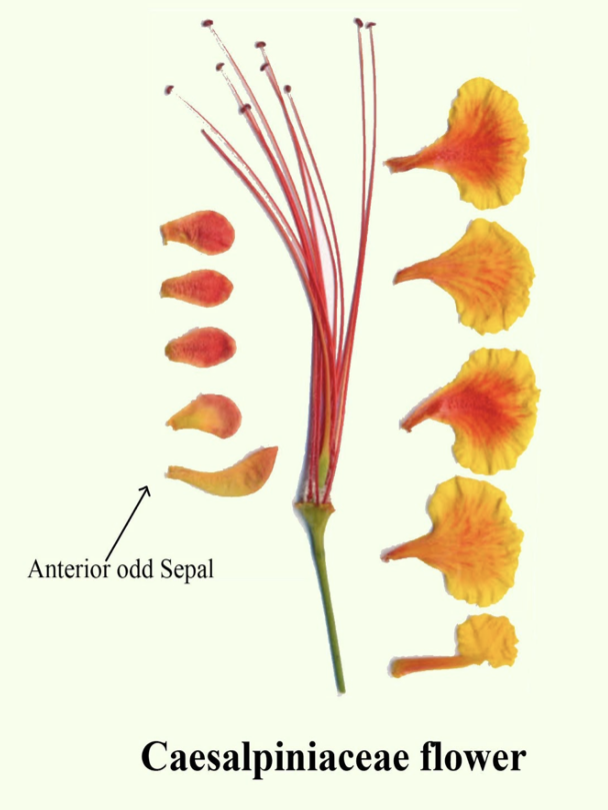
In family Caesalpiniaceae, odd sepal is
(a) Anterior
(b) Posterior
(c) Anterior-posterior
(d) None of the above
Answer
558k+ views
Hint: Caesalpiniaceae family is known also as the peacock flower subfamily. Their calyx consists of 5 green sepals, united or free. There is one modified petal which is smaller than the other 4 petals, flowers borne in terminal clusters.
Complete answer:
In Caesalpiniaceae, the odd sepal is in anterior condition, but in Solanaceae the odd sepal is posterior, which lies near the mother axis. They are mostly shrubs or trees. Leaves are large, pinnately, or pinnately compounds and stipulate. Stipules are either small or articulate. Flowers are big and showy forming clusters, they are bisexual, perigynous, and pentamerous.

Sepals 5, free, or connate, odd sepal anterior, imbricate aestivation. In Tamarindus the two posterior sepals are united. Petals 5, in Tamarindus there are only three posterior petals; in Copaifera saraca the petals are totally reduced; free, ascending imbricate aestivation, the posterior petal is innermost. Inflorescence mostly racemose or panicle. Fruit is long, legume; seed in some cases is endospermous.
Additional Information:
- Androecium consists of 10 stamens. Anthers are dithecous, basifixed or versatile, Dehiscing by longitudinal slits. Stamens are usually free, rarely connate, but sometimes reduced to staminodes or altogether abortive. In Cassia 3 to 5 stamens, reduced to staminodes, in Tamarindus sp. 3 stamens are well developed, while rest are reduced into staminodes.
- Gynoecium is monocarpellary, ovary is cylindrical with terminal style and a capitate stigma. ovary superior, unilocular; marginal placentation; style long; stigma simple.
- Ovary is unilocular with numerous ovules. Entomophilous pollination is usually seen.
So, the correct answer is '(a) Anterior'.
Note:
- The members of caesalpiniaceae are economically important. Flowers are used as an excellent uterine tonic.
- Fruits of some members are edible. Stem of some of them yields a fibre suitable for making paper, ropes etc.
- Twigs of some of them are used as fodder. Some of them are used in curing skin-diseases such as ringworm etc. Certain plants are grown as ornamental plants.
Complete answer:
In Caesalpiniaceae, the odd sepal is in anterior condition, but in Solanaceae the odd sepal is posterior, which lies near the mother axis. They are mostly shrubs or trees. Leaves are large, pinnately, or pinnately compounds and stipulate. Stipules are either small or articulate. Flowers are big and showy forming clusters, they are bisexual, perigynous, and pentamerous.

Sepals 5, free, or connate, odd sepal anterior, imbricate aestivation. In Tamarindus the two posterior sepals are united. Petals 5, in Tamarindus there are only three posterior petals; in Copaifera saraca the petals are totally reduced; free, ascending imbricate aestivation, the posterior petal is innermost. Inflorescence mostly racemose or panicle. Fruit is long, legume; seed in some cases is endospermous.
Additional Information:
- Androecium consists of 10 stamens. Anthers are dithecous, basifixed or versatile, Dehiscing by longitudinal slits. Stamens are usually free, rarely connate, but sometimes reduced to staminodes or altogether abortive. In Cassia 3 to 5 stamens, reduced to staminodes, in Tamarindus sp. 3 stamens are well developed, while rest are reduced into staminodes.
- Gynoecium is monocarpellary, ovary is cylindrical with terminal style and a capitate stigma. ovary superior, unilocular; marginal placentation; style long; stigma simple.
- Ovary is unilocular with numerous ovules. Entomophilous pollination is usually seen.
So, the correct answer is '(a) Anterior'.
Note:
- The members of caesalpiniaceae are economically important. Flowers are used as an excellent uterine tonic.
- Fruits of some members are edible. Stem of some of them yields a fibre suitable for making paper, ropes etc.
- Twigs of some of them are used as fodder. Some of them are used in curing skin-diseases such as ringworm etc. Certain plants are grown as ornamental plants.
Recently Updated Pages
Master Class 12 Business Studies: Engaging Questions & Answers for Success

Master Class 12 Economics: Engaging Questions & Answers for Success

Master Class 12 English: Engaging Questions & Answers for Success

Master Class 12 Maths: Engaging Questions & Answers for Success

Master Class 12 Social Science: Engaging Questions & Answers for Success

Master Class 12 Chemistry: Engaging Questions & Answers for Success

Trending doubts
What is meant by exothermic and endothermic reactions class 11 chemistry CBSE

Which animal has three hearts class 11 biology CBSE

10 examples of friction in our daily life

One Metric ton is equal to kg A 10000 B 1000 C 100 class 11 physics CBSE

1 Quintal is equal to a 110 kg b 10 kg c 100kg d 1000 class 11 physics CBSE

Difference Between Prokaryotic Cells and Eukaryotic Cells




